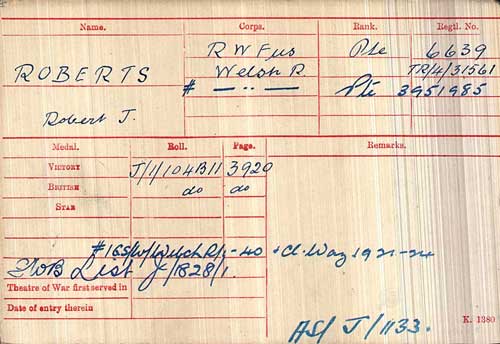Private Robert John Roberts [431561] - 18th November, 1915, to 13th February, 1919.
Regimental No: 4/31561
Badge No: B205181
Cause of Discharge: [Para 392 xvi K.R] Paragraph 392 "No longer physically fit for war service" Kings Regulations 1912.
Served overseas: Yes.
Place: Shrewesbury.
Date: 19th March, 1919.Name: R. J. Roberts
Address: Llecha, Llynfaen, Nr, Colwyn Bay, N. wales.53rd (Welsh) Division
The history of 53rd (Welsh) DivisionThe Welsh Division was a formation of the Territorial Force. It was formed as a result of the reforms of the army carried out in 1908 under the Secretary of State for War, Richard Burdon Haldane and was one of 14 Divisions of the peacetime TF.
1914
The units of the Division had just departed for annual summer camp when emergency orders recalled them to the home base. All units were mobilised for full time war service on 5 August 1914 and moved to their allotted positions at Shrewsbury, Wellington, Oswestry and Fort Scoveston by 11 August 1914. At the end of the month the entire Division moved to Northampton.
Several of the Division's units left in the period November 1914 – February 1915. They were gradually replaced by second line units, but these suffered from shortages of arms, slowing training. These units were subsequenetly replaced in early 1915.
The Division received a warning order on 18 November, advising preparation for a move to India, but this was cancelled a week later and eventually the 2nd Wessex Division went in its place. The Welsh Division moved to Cambridge in December.
1915
King George V inspected the Division on 11 February 1915. The Division moved to Bedford in May.
On 2 July the Division was ordered to refit for service in the Mediterranean. Leaving the artillery and train behind, the rest of the Division left 14-19 July and embarked at Devonport. Sailing via Alexandria (25-30 July), the ships reached Lemnos 29 July – 7 August. On 9 August units landed at Suvla Bay, Gallipoli. The Division was then involved in the following moves and engagements:
The landing at Suvla Bay (9-15 August)=
Operations in the Suvla Bay area=
= the battles marked = are phases of the Gallipoli campaignThe effects of fighting, few reinforcements and the dreadful blizzard of November reduced the Division to just 162 officers and 2428 men (about 15% of full strength). On 11-12 December the Division was evacuated to Mudros and then went on to Alexandria, where it began to arrive 20 December. The last units reached Wardan three days later.
1916
The divisional artillery rejoined at Wardan 11-22 February 1916.
The Battle of Romani (4-5 August)*
* the battles marked * are phases of the Palestine campaign1917
The First Battle of Gaza (26-27 March, 158th Brigade only)*
The Second Battle of Gaza (17-19 April)*
The Third Battle of Gaza (27 October -7 November)* including the Capture of Beersheba (31 October) and the Capture of Tell Khuweilfe (3-7 November)
The Capture of Jerusalem (7-9 December)*
The Defence of Jerusalem (27-30 December)
* the battles marked * are phases of the Palestine campaign1918
The battle of Tell'Asur (8-12 March)*
Between 4 June and 29 August 1918 the Division, other than the artillery, was "Indianised", which meant that Indian units arrived to replace most of the British ones. Many of the latter were ordered to France.
The battle of Nablus (18-21 September, part of the Battles of Megiddo)*
* the battles marked * are phases of the Palestine campaignOn 26 September the Division was withdrawn for rest and moved back to Tell'Asur. By 12 October it had moved to Ramle, and on 27 October began entraining for Alexandria. It was there when the Armistice with Turkey took effect on 31 October.
The first parties to be demobilised left for England on 22 December.The final cadres sailed home from Port Said on 15 June 1919. The Division reformed as part of the Territorial Army in April 1920.

 ©peh
©peh 
